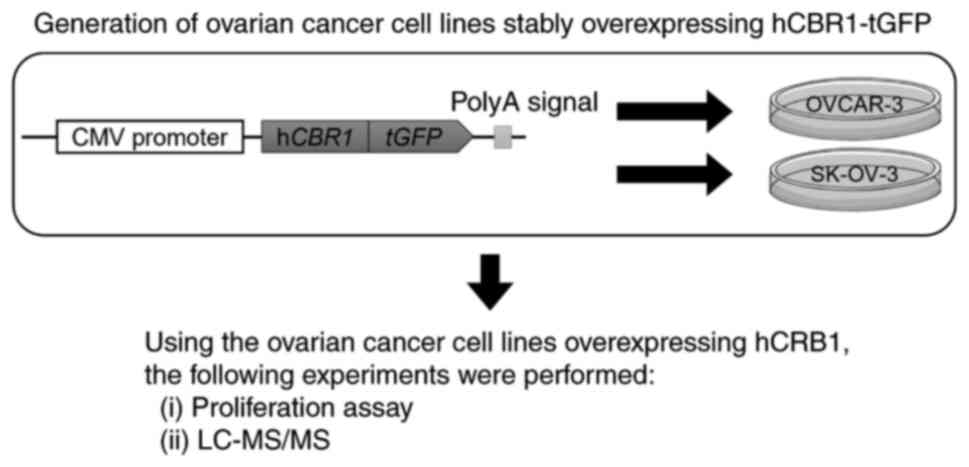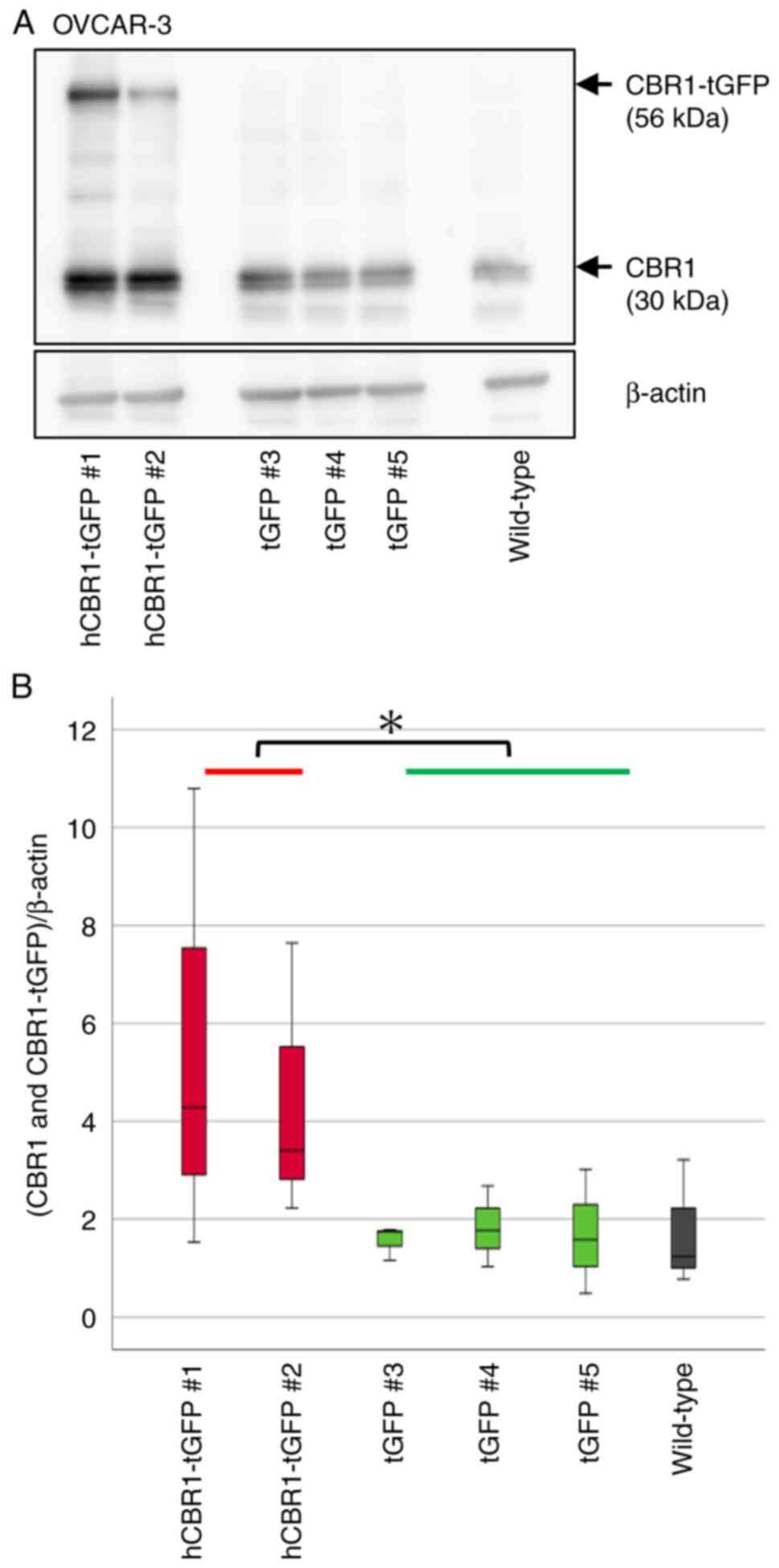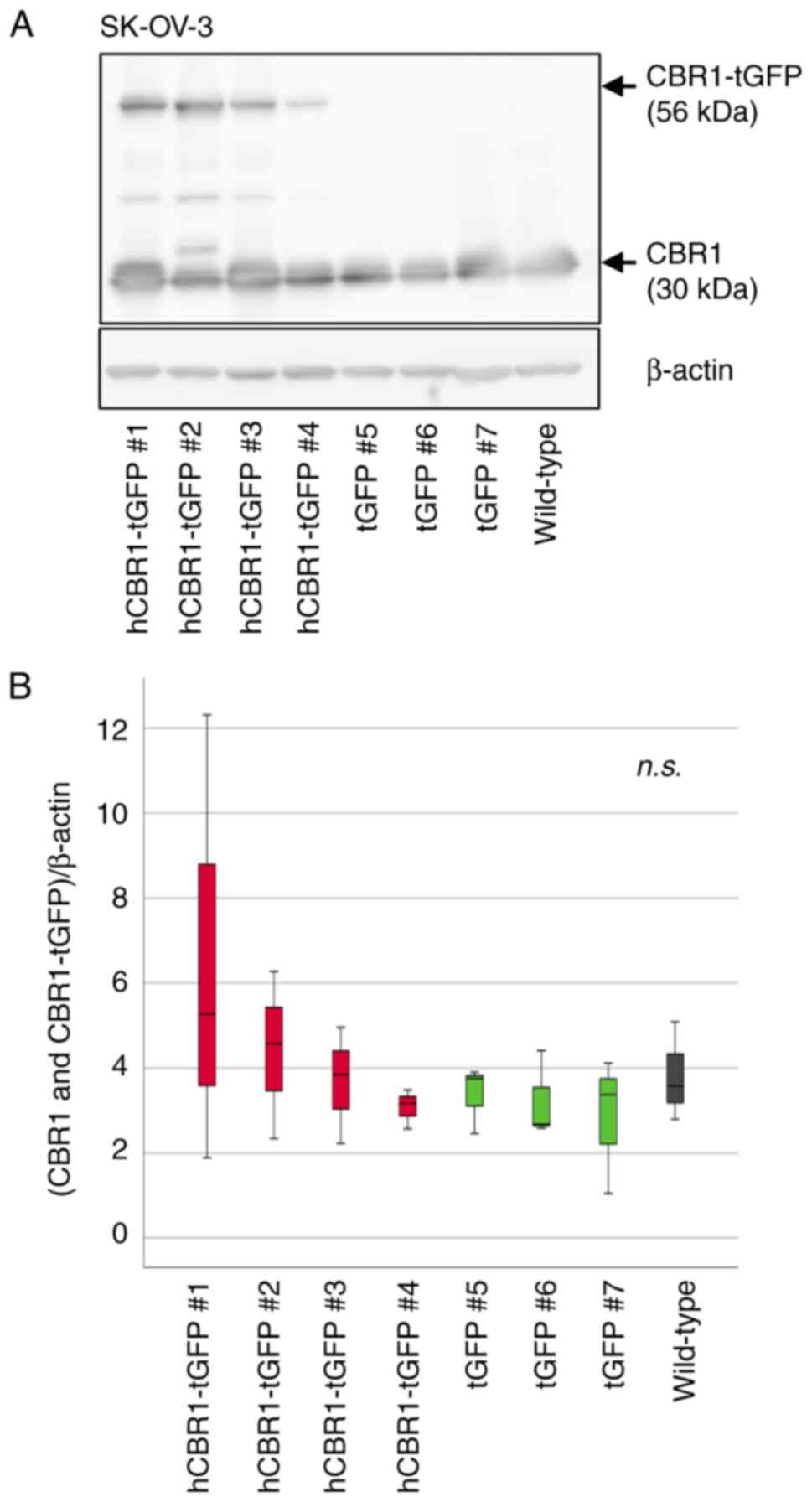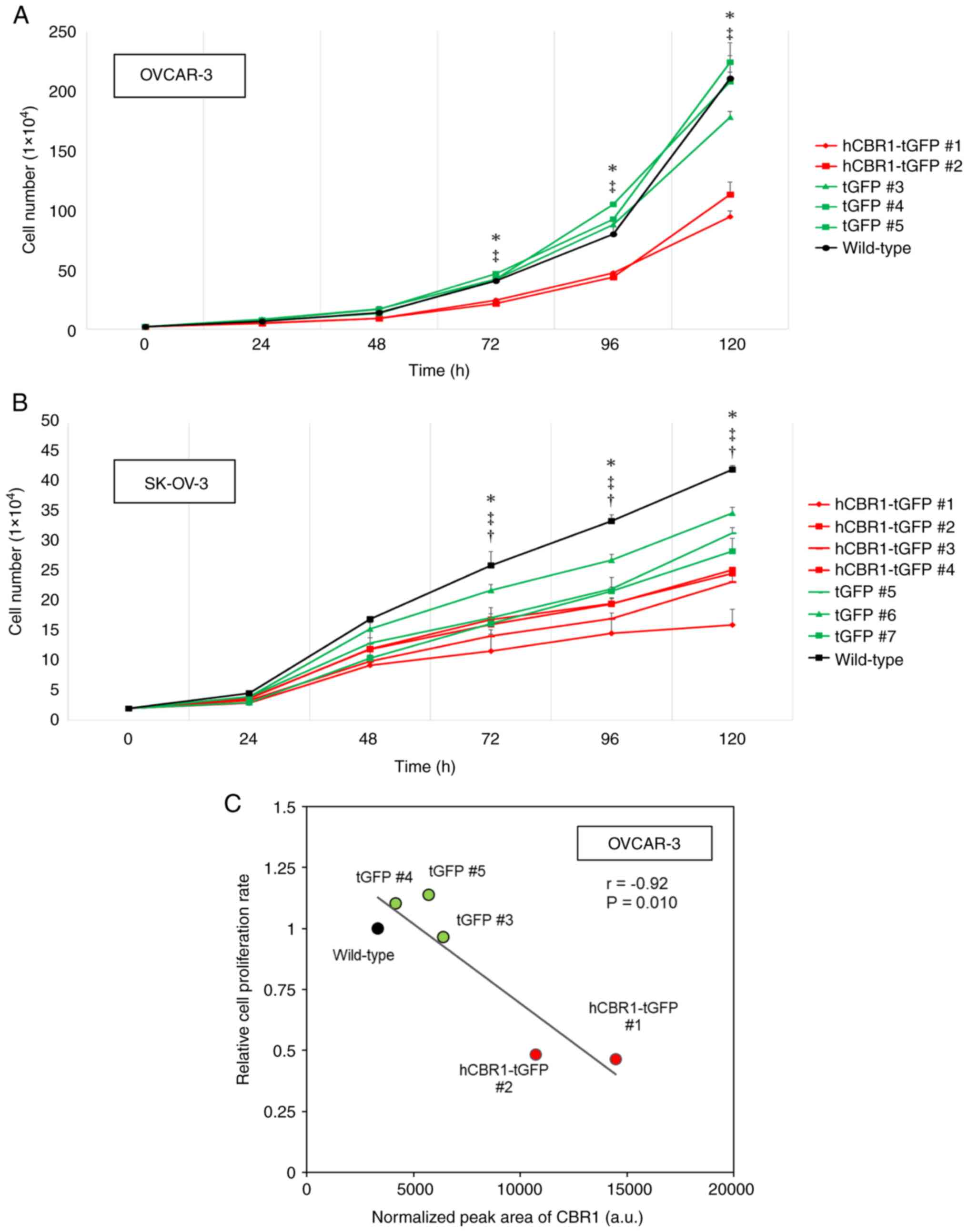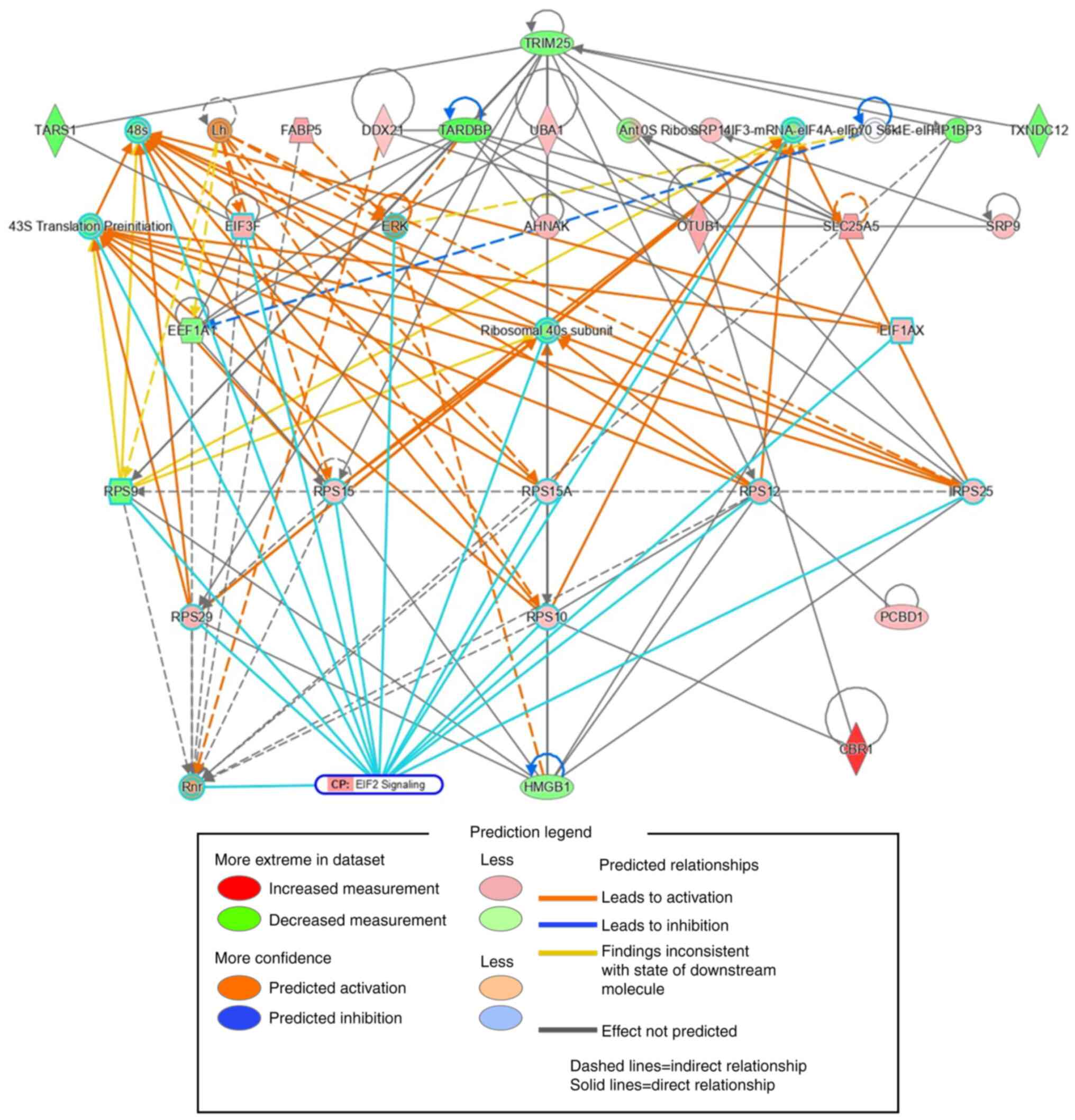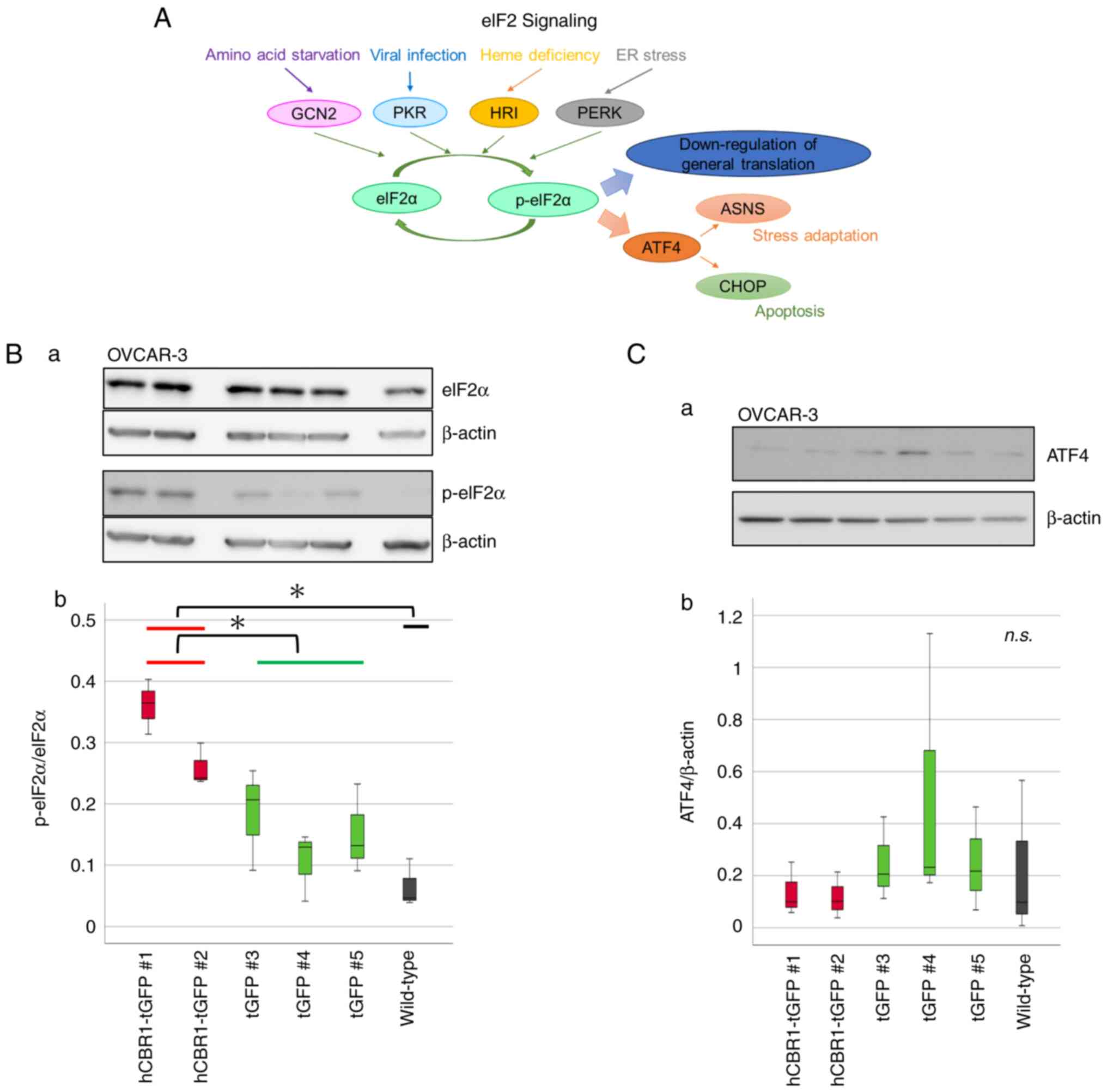Overexpression of carbonyl reductase 1 in ovarian cancer cells suppresses proliferation and activates the eIF2 signaling pathway
- Authors:
- Published online on: June 5, 2024 https://doi.org/10.3892/ol.2024.14492
- Article Number: 359
-
Copyright: © Kadonosawa et al. This is an open access article distributed under the terms of Creative Commons Attribution License.
Abstract
Introduction
Carbonyl reductase 1 (CBR1), an NADPH-dependent monomeric cytosolic enzyme with wide specificity for carbonyl compounds (1), is expressed in the intestinal tract, liver, kidneys, skin, and ovaries (2,3), where it reduces carbonyl compounds such as anthracyclines, daunorubicin, doxorubicin, and prostaglandins (3). Studies suggest that its primary function is regulation of fatty acid metabolism (3).
CBR1 expression levels are associated with cancer cell malignancy; for example, reduced expression is accompanied by a fall in expression of E-cadherin along with activation of matrix metalloproteinases, which promotes cell proliferation and tumorigenesis of ovarian, cervical, and endometrial cancers in vivo (4–6). Previously, we reported that the prognosis for patients with ovarian cancer showing low expression of CBR1 is worse than that of those with ovarian cancer overexpressing CBR1 (4). In addition, increased expression of CBR1 suppresses growth of ovarian cancer cells (6), whereas decreased expression promotes growth and metastasis (5). Our previous study also suggests that increased expression of CBR1 in ovarian cancer cells may exert antitumor effects by activating caspase pathways (6). CBR1 suppresses development of cervical cancer, uterine sarcoma, and non-small cell lung carcinoma (7–9). Taken together, these data suggest that CBR1 regulates fatty acid metabolism and suppresses tumor growth via different molecular mechanisms; however, the signaling cascades affected by changes in CBR1 expression have not been examined in detail.
Proteomics analysis involves systematic, comprehensive, and quantitative identification of the proteins (i.e., the proteome) present in a biological system (e.g., cells, tissues, organs, fluids, and whole organisms) at a specific point in time (10–12). The three main branches of proteomics used to characterize the function and location of proteins are (I) functional proteomics, (II) structural proteomics, and (III) expression proteomics. The information obtained can be used to predict new proteins involved in signal transduction and disease pathogenesis (13). Therefore, proteomics should be useful for elucidating the molecular mechanisms affected by increased or decreased expression of CBR1.
In this study, we used a proteomics analysis approach to examine signaling cascades altered by stable overexpression of CBR1 in ovarian cancer cells. The workflow of the study is shown in Fig. 1. We generated human ovarian cancer cell lines stably expressing human CBR1 (hCBR1), and then investigated whether their growth was inhibited. We then used liquid chromatography followed by mass spectrometry (LC-MS/MS) to identify the molecules/signaling pathways affected.
Materials and methods
Cell lines and cell culture
OVCAR-3 and SK-OV-3 cell lines were purchased from the American Type Culture Collection (HTB-161 and HTB-77, respectively; Rockville, MD, USA). These cell lines are derived from human ovarian cancer cell tissue and are often used to generate solid tumor xenografts (10,14–18). The cells were cultured in RPMI-1640 medium (Sigma-Aldrich, St Louis, MO, USA) at 37°C in a water-saturated atmosphere containing 5% CO2/95% air. The culture medium was supplemented with 10% fetal bovine serum (NICHIREI Biosciences, Tokyo, Japan), 100 U/ml penicillin, and 100 µg/ml streptomycin.
Preparation of plasmid DNA
The pCMV6-AC-GFP-hCBR1 plasmid (RG204950, OriGene Technologies, Inc., Rockville, MD, USA) was used to generate hCBR1-overexpressing cells. This plasmid encodes hCBR1 fused to turbo green fluorescent protein (hCBR1-tGFP), which is expressed under the control of the CMV promoter. Plasmid pCMV6-AC-GFP (PS100010, OriGene Technologies, Inc.), which expresses tGFP, was used to generate negative control cell lines.
Transfection of ovarian cancer cells
Ovarian cancer cells were plated into a 10 cm dish and cultured to 70–80% confluence. Cells were then transfected with 24 µg of pCMV6-AC-GFP-hCBR1 or pCMV6-AC-GFP using Lipofectamine 3000 (Life Technologies, Rockville, MD, USA) for 24 h at 37°C. Then, G418 (NACALAI TESQUE, Inc., Kyoto, Japan) was added (0.4 mg/ml) to the culture medium to select cell lines possessing the plasmid DNA in their genome.
Immunoblot analysis
Cells were homogenized on ice in radio-immunoprecipitation assay (RIPA) buffer (Fujifilm Wako, Osaka, Japan) containing cOmplete Mini EDTA-free Protease Inhibitor Cocktail Tablets provided in EASY packs (Roche, Basel, Switzerland). Protein measurements were performed using Bio-Rad Protein Assay Dye Reagent Concentrate (Bio-Rad Laboratories, Hercules, CA, USA). Proteins (8 µg) were loaded into the wells of 5–20% SDS-polyacrylamide gels (Fujifilm Wako), electrophoresed, and transferred to polyvinylidene difluoride membranes. The membranes were blocked for 1 h at room temperature with Tris-buffered saline (TBS) containing 0.05% Tween-20/1% skim milk or 2% bovine serum albumin [for the anti-phospho-translation initiation factor 2 (eIF2)α blot] and then incubated overnight at 4°C with a polyclonal rabbit anti-hCBR1 antibody (Ab) (1:1,000; ab-186825; Abcam, Cambridge, UK), an anti-β-actin Ab (1:5,000; M177-3; MBL, Tokyo, Japan), an anti-eIF2α Ab (1:5,000; 9722, Cell Signaling Technology, Danvers, MA, USA), an anti-phospho-eIF2α (p-eIF2α) Ab (1:5,000; 9721, Cell Signaling Technology), and an anti-activating transcription factor 4 (ATF4) Ab (1:1,000; ab-216839; Abcam). After washing with TBS/0.05% Tween-20, the membranes were incubated for 1 h at room temperature with an appropriate horseradish peroxidase (HRP)-conjugated secondary Ab [either anti-mouse IgG-HRP (NA9310V; GE Healthcare, Pittsburgh, PA, USA) or anti-rabbit IgG-HRP (NA9340V; GE Healthcare)]. Protein bands were detected using enhanced chemiluminescence (Image Quant LAS4000 system; GE Healthcare). The detected bands were quantified using Image J (19).
Evaluation of ovarian cancer cell proliferation
Wild-type, negative control, and hCBR1-tGFP-overexpressing ovarian cancer cells were plated in 6 cm dishes (1.0×104 cells/dish) and cultured at 37°C for 24, 48, 72, 96, or 120 h. Cells were then washed with 1 ml of Dulbecco's phosphate-buffered saline and detached with 0.5 g/l-Trypsin/0.53 mmol/l-EDTA Solution (NACALAI TESQUE, Inc., Kyoto, Japan). Trypan blue solution (0.1%; NACALAI TESQUE, Inc.) was used to discriminate living from dead cells; cells were counted using a hemocytometer (Bio Medical Science, Tokyo, Japan). The rate of cell growth was calculated as the slope of a linear fit created by plotting the natural logarithm of the cell number against culture time.
LC-MS/MS
Wild-type OVCAR-3 and five lots of OVCAR-3-derived cells overexpressing CBR1 were cultured and sampled in triplicate. Cell lysates were prepared as described for immunoblot analysis. Label-free whole cell proteomic analysis was performed as described previously (20). Briefly, cell lysates containing 20 µg of total protein, as determined by the bicinchoninic acid (BCA) method, were denatured with acetone. The precipitates were then denatured with 50% trifluoroethanol. Disulfide bonds were reduced with dithiothreitol (DTT) and alkylated with iodoacetamide followed by trypsin digestion. After desalting and purification of the resulting peptides using MonoSpin C18 columns (GL Sciences Inc., Tokyo, Japan), the samples were subjected to LC-MS/MS using a nanoLC system (Eksigent 400, AB Sciex, Framingham, MA, USA) coupled online to a mass spectrometer (TripleTOF6600, AB Sciex). Peptide separation was performed using LC on a nano C18 reverse-phase capillary tip column (75 µm × 125 mm, 3 µm, Nikkyo Technos CO., Tokyo, Japan) at 300 nl/min with a 90 min linear gradient of 8–30% acetonitrile in 0.1% FA, and then, with a 10 min linear gradient of 30 to 40% acetonitrile in 0.1% FA. The mass spectrometer was operated in information-dependent acquisition (IDA) and data-independent acquisition (SWATH) while in positive ion mode, scanning full spectra (400-1,500 m/z) for 250 msec, followed by up to 30 MS/MS scans (100-1,800 m/z for 50 msec each), for a cycle time of 1.8 sec. Candidate ions with a charge state between +2 and +5 and counts above a minimum threshold of 125 counts per second were isolated for fragmentation, and one MS/MS spectrum was collected before adding those ions to the exclusion list for 12 sec. For SWATH acquisition, the parameters were set as follows: 100 msec TOF MS scan, followed by 200 variable SWATH windows each at 50 msec accumulation time for m/z 400-1,250. MS/MS SWATH scans were set at 5 Da window overlapping by 1 Da for m/z 400-1,250 and varied on each side of the mass range. The total cycle time was 9.6 sec. A rolling collision energy parameters script was used to automatically control the collision energy. Database searching for acquired spectra was performed using ProteinPilot 5.0.1 software (AB Sciex). The positive identification threshold was set at a false discovery rate of 1% or less. The resulting library file and SWATH (data independent acquisition) files were processed by PeakView (ver. 2.2.0, AB Sciex) and exported to MarkerView (ver. 1.3.0.1; AB Sciex). The peak area of individual proteins was normalized relative to the sum of the peak areas of all detected proteins.
Statistical analysis and reproducibility
Experiments were performed in triplicate for immunoblot analysis and evaluation of ovarian cancer cell proliferation. Normal distribution was tested by Shapiro-Wilk test. Statistical differences between the three groups (hCBR1-tGFP-overexpressing, negative control, and wild-type cells) were analyzed using one-way ANOVA followed by Tukey's test (parametric data) or Kruskal-Wallis test (non-parametric data). P<0.05 was considered to indicate a statistically significant difference. All statistical analyses were performed using IBM SPSS ver. 29.0 statistics software (IBM, Chicago, Illinois).
Regarding the statistical analysis of the proteome data, principal component analysis using SIMCA software (version 15.0.2, Infocom Corp., Tokyo, Japan) confirmed that there was no outlier proteome in any of the samples. Since the cell lines used show endogenous CBR1 expression, proteins covarying with CBR1 were subjected to Spearman's rank correlation analysis and Pearson's correlation analysis (R version 4.1.0 software) to capture proteomic variations due to CBR1 transfection. Proteins with FDR-adjusted P<0.05 were identified as proteins covarying with CBR1 and subjected to pathway enrichment and network analysis by Ingenuity Pathway Analysis (IPA) software (Qiagen, Venlo, Netherland).
Results
Generation of ovarian cancer cells stably expressing hCBR1-tGFP
To investigate the role of CBR1 on the malignancy of ovarian cancer cells, we first generated OVCAR-3 and SK-OV-3 cell lines stably expressing hCBR1-tGFP. We also generated ovarian cancer cells expressing only tGFP as a control (negative control cells). Immunoblot analysis using an anti-CBR1 Ab revealed stable expression of hCBR1-tGFP (Figs. 2A and 3A). A band corresponding to hCBR1-tGFP was not observed in the negative control and wild-type cell samples. We measured CBR1 protein expression levels (i.e., the combined expression levels of hCBR1-tGFP and CBR1) in OVCAR-3 and SK-OV-3 cells using image analysis software (Figs. 2B and 3B). The results confirmed that expression of CBR1 protein in hCBR1-tGFP-overexpressing OVCAR-3 cells was significantly higher than that in wild-type and negative control cells (Fig. 2B). As to SK-OV-3 cells, hCBR1-tGFP-overexpressing cell #1 and #2 showed the highest and relatively high expression of CBR1 protein, respectively (Fig. 3B). Although all hCBR1-tGFP-overexpressing SK-OV-3 cells showed hCBR1-tGFP expression (Fig. 3A), the expression was slight in the cell line #4. Therefore, statistical significance on the total CBR1 amount was not observed among cell groups (Fig. 3B). Nevertheless, hCBR1-tGFP was visibly expressed in the cell line #4, and the other hCBR1-tGFP-expressing cells show a tendency of upregulation of total hCBR1 protein. To examine the importance of the CBR1 protein in ovarian cancer cells, these established SK-OV-3 cells were also used for subsequent experiments.
Antiproliferative effects of CBR1
To evaluate the effect of CBR1 overexpression on tumor cell growth, we measured proliferation of OVCAR-3 and SK-OV-3 cells expressing hCBR1-tGFP. As shown in Fig. 4A and B, growth of OVCAR-3 and SK-OV-3 cells expressing hCBR1-tGFP was slower than that of wild-type or negative control cells. These results suggest that overexpression of hCBR1 strongly inhibits growth of ovarian cancer cells, although it should be noted that overexpression of tGFP alone moderately affected growth of SK-OV-3 cells (Fig. 4B). hCBR1-tGFP-overexpressing OVCAR-3 cells showed significant suppression of cell proliferation (P<0.05, vs. negative control or wild-type) (Fig. 4A). hCBR1-tGFP-overexpressing SK-OV-3 cells also showed significant suppression of cell proliferation (P<0.05, vs. negative control or wild-type, Fig. 4B). As to SK-OV-3 cells, differences in cellular growth were also observed between wild-type and negative control cells (P<0.05, Fig. 4B). Because tGFP is potentially cytotoxic (21), expression of tGFP may also affect the growth of SK-OV-3 cells.
In hCBR1-tGFP-overexpressing OVCAR-3, we confirmed an inverse correlation between hCBR1 overexpression and cell proliferation (Fig. 4C). In the hCBR1-tGFP-overexpressing lines (#1, #2), CBR1 expression levels were high, and the cell proliferation rate was reduced. By contrast, negative control cells (#3-#5) and wild-type cells expressed low levels of CBR1 and showed higher proliferation rates. In these experiments, CBR1 expression is the sum of endogenous CBR1 and exogenous hCBR1-tGFP, and the higher levels of CBR1 protein in hCBR1-tGFP-overexpressing lines are consistent with the results shown in Fig. 1B. Thus, these results support the above data showing that hCBR1-tGFP-overexpressing lines grow more slowly than negative control and wild-type cells (Fig. 4A). Previously, we showed that transient expression of CBR1 in a xenograft mouse model may induce apoptosis through activation of caspase pathways (6). Thus, stable overexpression of hCBR1-tGFP may induce apoptosis in OVCAR-3 and SK-OV-3 cells.
Altered intracellular signaling in hCBR1-tGFP-overexpressing cancer cell lines
To elucidate the CBR1-mediated molecular mechanism underlying growth inhibition, we performed LC-MS/MS of OVCAR-3 cell lysates, followed by IPA. Whole cell proteomics analysis using a label-free quantification method plus MS resulted in quantification of 939 proteins, with no samples showing outliers upon principal component analysis (Fig. S1). Of these, the abundance of 155 proteins correlated significantly with expression of hCBR1 (FDR-adjusted P-value <0.05, Spearman's rank correlation, Fig. S2). We then performed IPA to identify enriched canonical pathways associated with hCBR1-correlated proteins; the top 20 pathways are shown in Table I. Expression of proteins involved in various signaling pathways, whose role in controlling tumor progression is suggested, correlated with expression of hCBR1. Among these, the eIF2 signaling pathway was the most enriched.
The z-score for the eIF2 signaling pathway, as calculated by IPA, was +1.387. The z-score indicates whether the detected signal is biased toward activation or inactivation, with positive values indicating activation and negative values indicating inactivation (Fig. S3). Table I shows that eIF2 signaling is highly affected by overexpression of hCBR1. Proteins associated with eIF2 signaling are listed in Table II. Of the 23 proteins associated with eIF2 signaling, 17 had positive correlation coefficients.
We also used IPA to perform a protein-protein interaction network analysis of hCBR1-correlated proteins. The top 35 out of the 155 proteins whose expression correlated with that of CBR1 were extracted in the order of interaction network robustness and presented as a subnetwork (Fig. 5). Among the 35 proteins, 15 formed a subnetwork related to eIF2 signaling, as shown by the cyan borders. These results suggest that the eIF2 signaling pathway may be involved in suppressing cell growth.
eIF2 phosphorylation status in OVCAR-3 cells stably expressing hCBR1-tGFP
Next, we investigated whether the eIF2 signaling pathway is actually altered by overexpression of hCBR1-tGFP. Considering the magnitude of changes in eIF2 signaling, and the critical importance of phosphorylation status of eIF2 during regulation of the pathway (Fig. 6A, see also the Discussion section) (22), we performed immunoblot analysis to examine phosphorylation of eIF2α, a subunit of eIF2. A clear band corresponding to p-eIF2α was observed in lysates prepared from hCBR1-tGFP-expressing cells (#1, #2) (Fig. 6B-a), confirming that overexpression of hCBR1 induces phosphorylation of eIF2α. Expression and phosphorylation of eIF2α protein in OVCAR-3 cells were quantified using image analysis software. The results confirmed that the phosphorylation levels of eIF2α in hCBR1-tGFP-overexpressing cells were higher than those in wild-type and negative control cells (Fig. 6B-b).
Phosphorylation of eIF2α downregulates general translation and upregulates expression of ATF4 (Fig. 6A) (22). Although we examined involvement of ATF4 downstream of eIF2α, we found that expression of ATF4 was not upregulated in hCBR1-tGFP-expressing cells (Fig. 6C). Therefore, overexpression of hCBR1 may induce downregulation of general translation via phosphorylation of eIF2α.
Discussion
In this study, we generated ovarian cancer cells stably expressing hCBR1-tGFP. Proliferation of hCBR1-tGFP-overexpressing cells was slower than that of negative control and wild-type cells. To elucidate the mechanism of cell growth suppression by CBR1 overexpression, we used proteomics together with IPA. The results showed marked differences in the expression of proteins involved in eIF2 signaling in hCBR1-tGFP-overexpressing cells. Concordantly, constitutive phosphorylation of eIF2α, which plays a critical role in eIF2 signaling, suggests that CBR1 regulates cell growth via the eIF2 signaling pathway.
Generally, it is accepted that protein synthesis drives the cell cycle (23). The relationship between regulation of protein synthesis and cancer cell growth has attracted considerable attention because regulation of mRNA translation is a convergence point for many oncogenic signals (24). The eIF2 signaling pathway plays a central role in regulating general translation in response to stress. eIF2 comprises three subunits: α, β, and γ. GTP-bound eIF2 interacts with the initiating methionyl-tRNA (ternary complex, TC) and transports it to the 40S ribosome (25). The elF2 translation initiation complex integrates a variety of stress-related signals to downregulate general translation, but it upregulates translation of specific mRNAs such as that encoding ATF4 (26). In this regard, because we did not show upregulation of ATF4 protein, it may be that overexpression of CBR1 downregulates general translation.
Phosphorylation of eIF2α is induced by a diverse family of four stress-activated kinases: protein kinase R (PKR) [induced by dsRNA], protein kinase RNA-like endoplasmic reticulum kinase (PERK) [induced by endoplasmic reticulum (ER) stress], general control nonderepressible-2 (GCN2) [induced by amino acid starvation], and heme-regulated inhibitor (HRI) [induced by heme deficiency] (Fig. 6A). As a limitation of this study, we could not confirm how CBR1 induces phosphorylation of eIF2α. Therefore, it would be interesting to examine this issue in future. We examined only one downstream eIF2α pathway-related molecule (ATF4) in this study. Therefore, we would like to examine the other downstream molecules and related physiological changes, including oxidative stress-induced reactive oxygen species generation, in a future study. On the other hand, in addition to OVCAR-3, hCBR1-tGFP-overexpressing SK-OV-3 cells were established in this study. Although all hCBR1-tGFP-overexpressing cells showed hCBR1-tGFP expression, statistical significance was not achieved as a group, which may also be a limitation of this study.
Initiation of protein synthesis is regulated by two rate-limiting steps: assembly of eukaryotic translation initiation factor 4F (eIF4F) and formation of the TC. Assembly of eIF4F is promoted by mechanistic target of rapamycin (mTOR) signaling (27). It is interesting to note that IPA revealed that within the proteome of hCBR1-tGFP-overexpressing cells, factors involved in mTOR signaling were among those whose levels changed (Table I), although it is unclear whether mTOR signaling fluctuates upwards or downwards (Fig. S3). Since the eIF2 signaling pathway and mTOR signaling are exquisitely coordinated to provide a robust response to cellular stress (28–30), overexpression of CBR1 may affect both pathways to suppress growth of ovarian cancer cells.
In this study, we demonstrated regulation of the eIF2 signaling pathway by CBR1. Although further studies are needed, our data suggest a new therapeutic strategy for ovarian cancer based on targeting CBR1 and related signaling cascades. This could be achieved by developing molecularly targeted drugs directed at components of the eIF2 signaling pathway, as well as CBR1 itself. In addition, CBR1 may be a potential biomarker of medical prognosis.
Supplementary Material
Supporting Data
Acknowledgements
The authors would like to thank Dr Hodaka Fujii (Hirosaki University Graduate School of Medicine), for helpful discussion and critical reading of the manuscript. They also would like to thank Ms. Miyu Miyazaki (Center for Scientific Equipment Management, Hirosaki University Graduate School of Medicine), for technical support with mass spectrometry.
Funding
This work was supported by a JSPS KAKENHI grant (grant no. 20K09589, to YY).
Availability of data and materials
The proteomics data generated in the present study may be found in the Proteome Xchange and jPOST Repositor databases under accession numbers PXD039299 and JPST001979, respectively or at the following URLs: https://proteomecentral.proteomexchange.org/cgi/GetDataset?ID=PXD039299 and https://repository.jpostdb.org/entry/JPST001979.2. The other data generated in the present study may be requested from the corresponding author.
Authors' contributions
YK, MY and YY conceived the project. TF and YY designed and supervised the project. YT performed LC-MS/MS analysis. YK and MY performed the other experiments. YK, MY, TF and YY wrote the manuscript. YK and MY confirm the authenticity of all the raw data. All authors read and approved the final version of the manuscript.
Ethics approval and consent to participate
Not applicable.
Patient consent for publication
Not applicable.
Competing interests
The authors declare that they have no competing interests.
Glossary
Abbreviations
Abbreviations:
|
CBR1 |
carbonyl reductase 1 |
|
hCBR1 |
human CBR1 |
|
eIF |
eukaryotic translation initiation factor |
|
tGFP |
turbo green fluorescent protein |
|
LC-MS/MS |
liquid chromatography followed by mass spectrometry |
|
p-eIF2 |
phosphorylated-eIF2 |
|
HRP |
horseradish peroxidase |
|
IPA |
Ingenuity Pathway Analysis |
|
TC |
ternary complex |
|
PKR |
protein kinase R |
|
PERK |
protein kinase RNA-like endoplasmic reticulum kinase |
|
GCN2 |
general control nonderepressible-2 |
|
HRI |
heme-regulated inhibitor |
|
ATF4 |
activating transcription factor 4 |
|
mTOR |
mechanistic target of rapamycin |
|
Ab |
antibody |
References
|
Mindnich RD and Penning TM: Aldo-keto reductase (AKR) superfamily: Genomics and annotation. Hum Genomics. 3:362–370. 2009. View Article : Google Scholar : PubMed/NCBI | |
|
Fagerberg L, Hallström BM, Oksvold P, Kampf C, Djureinovic D, Odeberg J, Habuka M, Tahmasebpoor S, Danielsson A, Edlund K, et al: Analysis of the human tissue-specific expression by genome-wide integration of transcriptomics and antibody-based proteomics. Mol Cell Proteomics. 13:397–406. 2014. View Article : Google Scholar : PubMed/NCBI | |
|
Wermuth B, Bohren KM, Heinemann G, von Wartburg JP and Gabbay KH: Human carbonyl reductase. Nucleotide sequence analysis of a cDNA and amino acid sequence of the encoded protein. J Biol Chem. 263:16185–16188. 1988. View Article : Google Scholar : PubMed/NCBI | |
|
Umemoto M, Yokoyama Y, Sato S, Tsuchida S, Al-Mulla F and Saito Y: Carbonyl reductase as a significant predictor of survival and lymph node metastasis in epithelial ovarian cancer. Br J Cancer. 85:1032–1036. 2001. View Article : Google Scholar : PubMed/NCBI | |
|
Osawa Y, Yokoyama Y, Shigeto T, Futagami M and Mizunuma H: Decreased expression of carbonyl reductase 1 promotes ovarian cancer growth and proliferation. Int J Oncol. 46:1252–1258. 2015. View Article : Google Scholar : PubMed/NCBI | |
|
Miura R, Yokoyama Y, Shigeto T, Futagami M and Mizunuma H: Inhibitory effect of carbonyl reductase 1 on ovarian cancer growth via tumor necrosis factor receptor signaling. Int J Oncol. 47:2173–2180. 2015. View Article : Google Scholar : PubMed/NCBI | |
|
Nishimoto Y, Murakami A, Sato S, Kajimura T, Nakashima K, Yakabe K, Sueoka K and Sugino N: Decreased carbonyl reductase 1 expression promotes tumor growth via epithelial mesenchymal transition in uterine cervical squamous cell carcinomas. Reprod Med Biol. 17:173–181. 2018. View Article : Google Scholar : PubMed/NCBI | |
|
Kajimura T, Sato S, Murakami A, Hayashi-Okada M, Nakashima K, Sueoka K and Sugino N: Overexpression of carbonyl reductase 1 inhibits malignant behaviors and epithelial mesenchymal transition by suppressing TGF-β signaling in uterine leiomyosarcoma cells. Oncol Lett. 18:1503–1512. 2019.PubMed/NCBI | |
|
Takenaka K, Ogawa E, Oyanagi H, Wada H and Tanaka F: Carbonyl reductase expression and its clinical significance in non-small-cell lung cancer. Cancer Epidemiol Biomarkers Prev. 14:1972–1975. 2005. View Article : Google Scholar : PubMed/NCBI | |
|
Graves PR and Haystead TA: Molecular biologist's guide to proteomics. Microbiol Mol Biol Rev. 66:39–63. 2002. View Article : Google Scholar : PubMed/NCBI | |
|
Chandramouli K and Qian PY: Proteomics: Challenges, techniques and possibilities to overcome biological sample complexity. Hum Genomics Proteomics. 8:2392042009.PubMed/NCBI | |
|
Wang D, Eraslan B, Wieland T, Hallström B, Hopf T, Zolg DP, Zecha J, Asplund A, Li LH, Meng C, et al: A deep proteome and transcriptome abundance atlas of 29 healthy human tissues. Mol Syst Biol. 15:e85032019. View Article : Google Scholar : PubMed/NCBI | |
|
Martínez-Rodríguez F, Limones-González JE, Mendoza-Almanza B, Esparza-Ibarra EL, Gallegos-Flores PI, Ayala-Luján JL, Godina-González S, Salinas E and Mendoza-Almanza G: Understanding cervical cancer through proteomics. Cells. 10:18542021. View Article : Google Scholar : PubMed/NCBI | |
|
Shigeto T, Yokoyama Y, Xin B and Mizunuma H: Peroxisome proliferator-activated receptor α and γ ligands inhibit the growth of human ovarian cancer. Oncol Rep. 18:833–840. 2007.PubMed/NCBI | |
|
Wakui M, Yokoyama Y, Wang H, Shigeto T, Futagami M and Mizunuma H: Efficacy of a methyl ester of 5-aminolevulinic acid in photodynamic therapy for ovarian cancers. J Cancer Res Clin Oncol. 136:1143–1150. 2010. View Article : Google Scholar : PubMed/NCBI | |
|
Cebulla J, Huuse EM, Pettersen K, van der Veen A, Kim E, Andersen S, Prestvik WS, Bofin AM, Pathak AP, Bjørkøy G, et al: MRI reveals the in vivo cellular and vascular response to BEZ235 in ovarian cancer xenografts with different PI3-kinase pathway activity. Br J Cancer. 112:504–513. 2015. View Article : Google Scholar : PubMed/NCBI | |
|
Zalewski M, Kulbacka J, Saczko J, Drag-Zalesinska M and Choromanska A: Valspodar-modulated chemotherapy in human ovarian cancer cells SK-OV-3 and MDAH-2774. Bosn J Basic Med Sci. 19:234–241. 2019.PubMed/NCBI | |
|
Lu T, Tang J, Shrestha B, Heath BR, Hong L, Lei YL, Ljungman M and Neamati N: Up-regulation of hypoxia-inducible factor antisense as a novel approach to treat ovarian cancer. Theranostics. 10:6959–6976. 2020. View Article : Google Scholar : PubMed/NCBI | |
|
Ohgane K and Yoshioka H: Quantification of gel bands by an image J Macro, Band/Peak Quantification Tool v1. Protocols.io. 2019.doi:/10.17504/protocols.io.7vghn3w. | |
|
Yokoyama M, Fujita T, Kadonosawa Y, Tatara Y, Motooka D, Ikawa M, Fujii H and Yokoayama Y: Development of transgenic mice overexpressing mouse carbonyl reductase 1. Mol Biol Rep. 50:531–540. 2023. View Article : Google Scholar : PubMed/NCBI | |
|
Costantini LM, Fossati M, Francolini M and Snapp EL: Assessing the tendency of fluorescent proteins to oligomerize under physiologic conditions. Traffic. 13:643–649. 2013. View Article : Google Scholar | |
|
Boye E and Grallert B: eIF2α phosphorylation and the regulation of translation. Curr Genet. 66:293–297. 2020. View Article : Google Scholar : PubMed/NCBI | |
|
Johnston GC, Pringle JR and Hartwell LH: Coordination of growth with cell division in the yeast Saccharomyces cerevisiae. Exp Cell Res. 105:79–98. 1977. View Article : Google Scholar : PubMed/NCBI | |
|
Kovalski JR, Kuzuoglu-Ozturk D and Ruggero D: Protein synthesis control in cancer: selectivity and therapeutic targeting. EMBO J. 41:e1098232022. View Article : Google Scholar : PubMed/NCBI | |
|
Clemens MJ and Bommer UA: Translational control: The cancer connection. Int J Biochem Cell Biol. 31:1–23. 1999. View Article : Google Scholar : PubMed/NCBI | |
|
Hinnebusch AG: Molecular mechanism of scanning and start codon selection in eukaryotes. Microbiol Mol Biol Rev. 75:434–467. 2011. View Article : Google Scholar : PubMed/NCBI | |
|
Harris AL: Hypoxia-a key regulatory factor in tumour growth. Nat Rev Cancer. 2:38–47. 2002. View Article : Google Scholar : PubMed/NCBI | |
|
Hinnebusch AG: The scanning mechanism of eukaryotic translation initiation. Annu Rev Biochem. 83:779–812. 2014. View Article : Google Scholar : PubMed/NCBI | |
|
Gandin V, Masvidal L, Cargnello M, Gyenis L, McLaughlan S, Cai Y, Tenkerian C, Morita M, Balanathan P, Jean-Jean O, et al: mTORC1 and CK2 coordinate ternary and eIF4F complex assembly. Nat Commun. 7:111272016. View Article : Google Scholar : PubMed/NCBI | |
|
Wengrod J, Wang D, Weiss S, Zhong H, Osman I and Gardner LB: Phosphorylation of eIF2α triggered by mTORC1 inhibition and PP6C activation is required for autophagy and is aberrant in PP6C-mutated melanoma. Sci Signal. 8:ra272015. View Article : Google Scholar : PubMed/NCBI |



